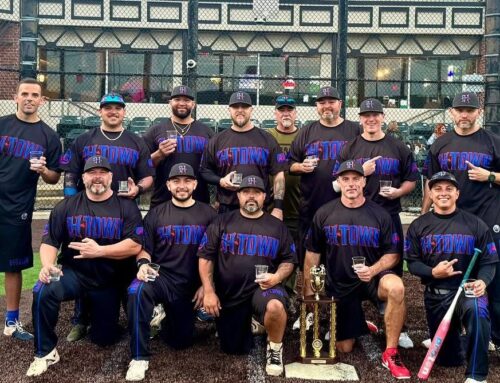A Mid-Century Modern paradise, the Hobby area neighborhood Glenbrook Valley is a hidden jewel in the heart of the Hobby Area District. Its rich history adds context and personality to an already charming, mature neighborhood. (The quick commute to Downtown doesn’t hurt, either.)
We got the rundown from Glenbrook Valley expert and real estate savant, Robert Searcy to learn more about this Hobby Area gem.
- For those who may be less familiar with Glenbrook Valley, can you tell us a bit about the history of the area?
Glenbrook Valley was developed around 1954-62. It definitely leaned more upscale, with the most expensive sections having prices that would have rivaled neighborhoods like River Oaks or Tanglewood back in the ‘50s and ‘60s. It was often referred to as the “River Oaks of the Eastside” or the “Italian River Oaks” because many of Houston’s well-known Italian and Sicilian families originally resided here, such as the Carrabbas, Mandolas and Montalbanos. - The neighborhood’s Mid-Century Modern style is well-known throughout Houston. What are some of the defining characteristics of this aesthetic?
MCM homes show strong modernist influences, with features such as flat or low-pitched roofs, clerestory windows, lots of floor to ceiling glass & solid slab doors. These are easy to recognize as MCM, however, there are ranch styles and more traditional homes that also share many great architectural details with the mods like great natural light, poured terrazzo, vaulted ceilings & wonderful flagstone accents (both inside and outside). - What can you tell us about Glenbrook Valley’s demographics?
Glenbrook Valley is a mix of families with kids, retirees, young working professionals and everything in between. This is one of the neighborhood’s strengths. It truly reflects the whole diversity of Houston. You have long-term retirees, younger buyers (often priced out of areas like Montrose and the Heights), as well as those that have chosen to “cash in” their modest but expensive homes in neighborhoods like Oak Forest, and get a much nicer home without adding to their commute. We also see some “commuter-weary” suburbanites who find the location just eight miles from Downtown very attractive. - Aside from the Hobby Area District, are there any civic associations operating in Glenbrook Valley?
What is officially Glenbrook Valley proper falls under one all-volunteer run civic club which produces a monthly newsletter and enforces the deed restrictions, among other things. They do a great job. There are adjacent areas that have civic clubs, such as Meadowbrook Freeway, which is on the east side of the neighborhood, and North Hobby, that covers an area between Drouet and Bellfort just outside of Glenbrook’s boundaries. - What three things would you promote about the neighborhood to people considering a move to Glenbrook Valley?
1. Location. We’re very close to major employment centers, only about eight miles to Downtown, close to the Medical Center, the major Universities and Hobby Airport (of course).
2. Character. It’s hard to quantify, but you know it when you see it. Glenbrook isn’t cookie-cutter, it has many unique custom-built homes, larger lots than most neighborhoods, lots of trees, and even some rolling terrain in parts, something very unusual for Houston.
3. The people. It’s truly a community. There are neighborhood get-togethers and Facebook pages, and people willing to fight to improve and advance the neighborhood. You can get to know a lot of great people there without too much effort! - When is the best time of year to buy a home in Glenbrook Valley, or another Hobby area neighborhood?
The best time is when you find a house you fall in love with! Jump on it IMMEDIATELY because it won’t be available for long. Many houses in Glenbrook Valley were originally custom-built, with specially chosen architects and builders. Sixty years of aging and updates have resulted in one-of-kind homes. I like to tell people, if a house “speaks to you” don’t let it get away! It’s a huge mistake to assume there will be another one like it, especially in Glenbrook Valley. - What can you tell us about the real estate forecast for the Hobby area in the coming years?
Past performance is no guarantee of future performance, but we’ve seen prices rise considerably in the last few years. The Hobby Area District’s plans for Bellfort Station could play an important role in increasing property value. Additionally, 80 acres of multi-family properties near Hobby Airport have recently come under one entities’ ownership. They have publicly stated they have plans for redeveloping parts into new mixed-use developments. This news, combined with the expansion of the Gulfgate TIRZ to include Broadway, the opening of the world-class Houston Botanic Garden in the area next year, and other concepts outlined in the HGAC Livable Centers Study for the area, such as creating an Artisan Industrial Hub near the 1940 Airport Terminal Museum, are all very intriguing and have enormous potential to be “game changers” for the area. Time will tell if/when these projects come to fruition, but overall things seem to be trending positively. - Anything else folks should know about Glenbrook Valley?
Glenbrook sits next to Sims Bayou, so I think a lot of folks assume there was significant flooding in Harvey and/or Allison. Sims did not flood over its banks in Harvey, Allison or Ike. There were very, very few homes in Glenbrook Valley that sat in low spots and took in water during the worst of Harvey, but the homes backing directly up to Sims Bayou did not flood. This area has fared extremely well in recent floods.
Interested in buying or selling a home in Glenbrook Valley? Contact Robert Searcy.





